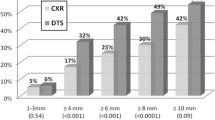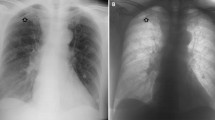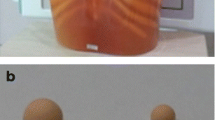Abstract
Objectives
To compare the diagnostic performance of digital tomosynthesis (DTS) and chest radiography for detecting airway abnormalities, using computed tomography (CT) as a reference.
Materials and methods
We evaluated 161 data sets from 149 patients (91 with and 70 without airway abnormalities) who had undergone radiography, DTS, and CT to detect airway problems. Radiographs and DTS were evaluated to localize and score the severity of the airway abnormalities, and to score the image quality using CT as a reference. Receiver operating characteristics (ROC), McNemar’s test, weighted kappa, and the paired t-test were used for statistical analysis.
Results
The sensitivity of DTS was higher (reader 1, 93.51 %; reader 2, 94.29 %) than chest radiography (68.83 %; 71.43 %) in detecting airway lesions. The diagnostic accuracy of DTS (90.91 %; 94.70 %) was also significantly better than that of radiography (78.03 %; 82.58 %, all p < 0.05). DTS image quality was significantly better than chest radiography (1.83, 2.74; p < 0.05) in the results of both readers. The inter-observer agreement with respect to DTS findings was moderate and superior when compared to radiography findings.
Conclusions
DTS is a more accurate and sensitive modality than radiography for detecting airway lesions that are easily obscured by soft tissue structures in the mediastinum.
Key Points
• Digital tomosynthesis offers new diagnostic options for airway lesions.
• Digital tomosynthesis is more sensitive and accurate than radiography for airway lesions.
• Digital tomosynthesis shows better image quality than radiography.
• Assessment of lesion severity, via tomosynthesis is comparable to computed tomography.





Similar content being viewed by others
References
Chou SH, Kicska GA, Pipavath SN, Reddy GP (2014) Digital tomosynthesis of the chest: current and emerging applications. Radiographics 34(2):359–372
Speets AM, van der Graaf Y, Hoes AW et al (2006) Chest radiography in general practice: indications, diagnostic yield and consequences for patient management. Br J Gen Pract 56(529):574–578
Geitung JT, Skjaerstad LM, Gothlin JH (1999) Clinical utility of chest roentgenograms. Eur Radiol 9(4):721–723
Coxson HO, Rogers RM (2005) Quantitative computed tomography of chronic obstructive pulmonary disease. Acad Radio 112(11):1457–1463
Henschke CI (2000) Early lung cancer action project: overall design and findings from baseline screening. Cancer 89(11 Suppl):2474–2482
Aberle DR, Berg CD, Black WC et al (2011) The national lung screening trial: overview and study design. Radiology 258(1):243–253
Payne JT (2005) CT radiation dose and image quality. Radiol Clin N Am 43(6):953–962
Mayo JR, Aldrich J, Muller NL (2003) Radiation exposure at chest CT: a statement of the fleischner society. Radiology 228(1):15–21
Jung HN, Chung MJ, Koo JH, Kim HC, Lee KS (2012) Digital tomosynthesis of the chest: utility for detection of lung metastasis in patients with colorectal cancer. Clin Radiol 67(3):232–238
Yamada Y, Jinzaki M, Hashimoto M et al (2013) Tomosynthesis for the early detection of pulmonary emphysema: diagnostic performance compared with chest radiography, using multidetector computed tomography as reference. Eur Radiol 23(8):2118–2126
Kim EY, Chung MJ, Choe YH, Lee KS (2012) Digital tomosynthesis for aortic arch calcification evaluation: performance comparison with chest radiography with CT as the reference standard. Acta Radiol 53(1):17–22
Park SJ, Choo JY, Lee KY et al (2014) Usefulness of digital tomosynthesis for the detection of airway obstruction: a case report of bronchial carcinosarcoma. Cancer Res Treat. doi:10.4143/crt.2013.220
Vikgren J, Zachrisson S, Svalkvist A et al (2008) Comparison of chest tomosynthesis and chest radiography for detection of pulmonary nodules: human observer study of clinical cases. Radiology 249(3):1034–1041
Eng J (2003) Sample size estimation: how many individuals should be studied? Radiology 227(2):309–313
Kim EY, Chung MJ, Lee HY, Koh WJ, Jung HN, Lee KS (2010) Pulmonary mycobacterial disease: diagnostic performance of low-dose digital tomosynthesis as compared with chest radiography. Radiology 257(1):269–277
Marom EM, Goodman PC, McAdams HP (2001) Focal abnormalities of the trachea and main bronchi. Am J Roentgenol 176(3):707–711
Lee G, Jeong YJ, Kim KI et al (2013) Comparison of chest digital tomosynthesis and chest radiography for detection of asbestos-related pleuropulmonary disease. Clin Radiol 68(4):376–382
Doo KW, Kang EY, Yong HS, Ham SY, Lee KY, Choo JY (2014) Comparison of chest radiography, chest digital tomosynthesis and low dose MDCT to detect small ground-glass opacity nodules: an anthropomorphic chest phantom study. Eur Radiol 4(12):3269–3276
Zachrisson S, Vikgren J, Svalkvist A et al (2009) Effect of clinical experience of chest tomosynthesis on detection of pulmonary nodules. Acta Radiol 50(8):884–891
Wall BF, Hart D (1997) Revised radiation doses for typical X-ray examinations. Report on a recent review of doses to patients from medical X-ray examinations in the UK by the National Radiological Protection Board. Brit J Radiol 70(833):437–439
Gomi T (2011) X-ray digital linear tomosynthesis iImaging for artificial pulmonary nodule detection. J Clin Imaging Sci 1:16
Acknowledgments
The scientific guarantor of this publication is Ki Yeol Lee. The authors of this manuscript declare no relationships with any companies, whose products or services may be related to the subject matter of the article. The authors state that this work has not received any funding. Statisticians kindly provided statistical advice for this manuscript. One of the authors (Ami Yu) has significant statistical expertise. Institutional Review Board approval was obtained. Written informed consent was obtained from all subjects (patients) in this study. No study subjects or cohorts have been previously reported. Methodology: prospective, diagnostic or prognostic study, performed at one institution.
Author information
Authors and Affiliations
Corresponding author
Rights and permissions
About this article
Cite this article
Choo, J.Y., Lee, K.Y., Yu, A. et al. A comparison of digital tomosynthesis and chest radiography in evaluating airway lesions using computed tomography as a reference. Eur Radiol 26, 3147–3154 (2016). https://doi.org/10.1007/s00330-015-4127-z
Received:
Revised:
Accepted:
Published:
Issue Date:
DOI: https://doi.org/10.1007/s00330-015-4127-z




